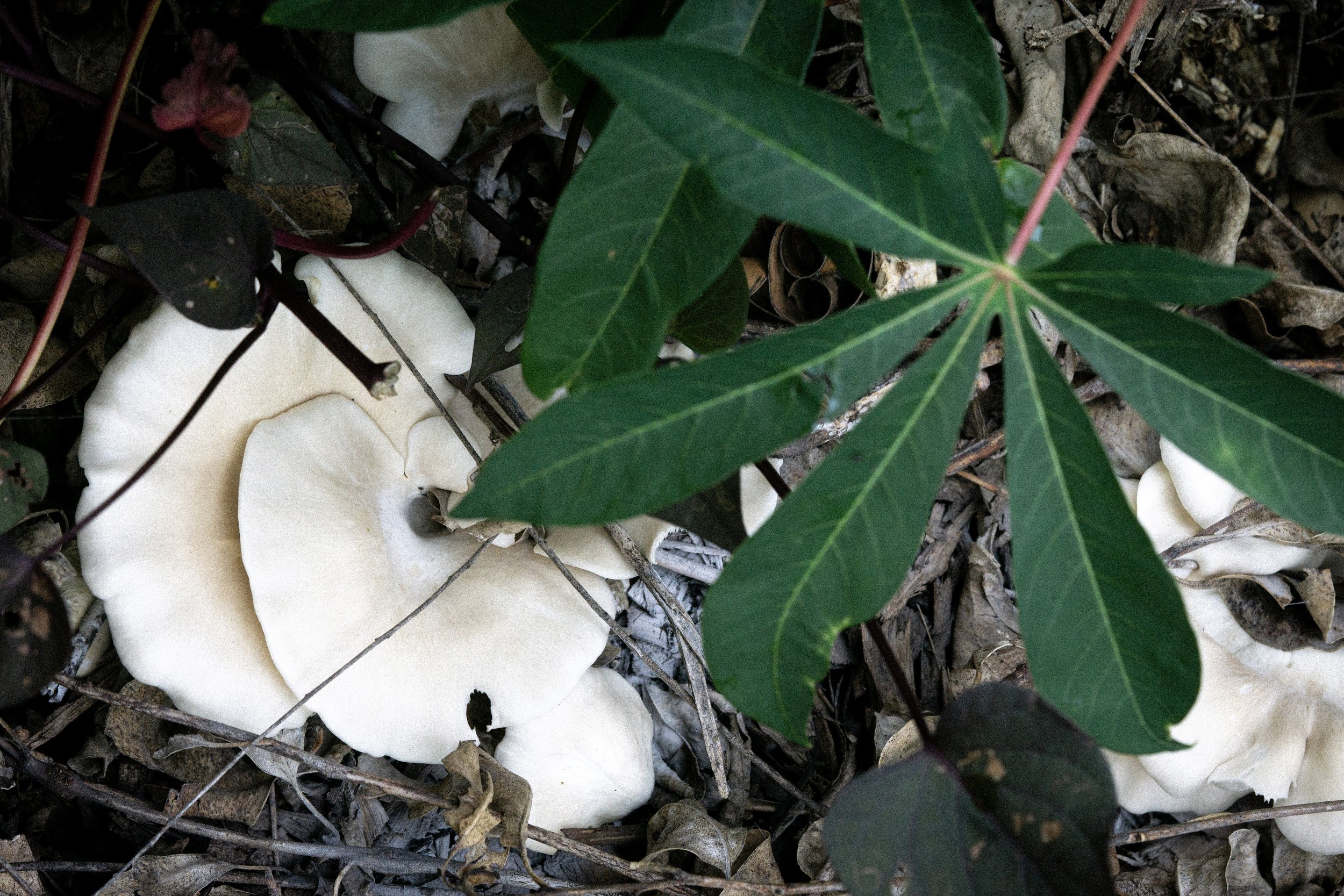Growing your own mushrooms has a positive impact on the planet
Fungi are ancient beings that have paved the way for many evolutionary branches and continue to support life and the well-being of our ecosystem. By intentionally bringing select medicinal mushroom species into your environment, you can facilitate a bloom of beneficial life, food, medicine, beauty, awe and wonder.
Mushrooms thrive best in diverse environments, decentralized into new territory they spread their medicine. All parts of fungi have medicinal value. Fungi as a whole can help regenerate the health and vitality of our great mother earth. There are many ways you can incorporate medicinal mushroom medicine into their life. For simplicity, we will mention 3 methods which can be interpreted and implemented with infinite creativity.
1. Bucket (or vessel of choice)
2. Inoculate into garden beds
3. Log inoculation
** think of ‘Inoculation’ as impregnating
Figure 1.
Native Pink Oyster Mushrooms (Pleurotus djamor) fruiting from sugarcane mulch using bucket technique.
There is a key commonality between all of the above-mentioned methods.
…MYCELIUM.
Figure 2.
King Stropharia (stropharia rugosoannulata) Mycelium growing on mix woodchip
Mycelium is the vegetative state of fungi, the thin fine white filaments spanning networks throughout soils, wood and most of matter (See Figure 2). They excrete potent enzymes and acids (See figure 3) to break down and digest nutrients which are then shared as bioavailable nutrients for plants or taken up to alchemized into complex medicinal structures within the fungi itself. They’re capacity to extend into far reaches of the earth and create networks of communication are few of what unites all of nature. Fungi are natures internet.
Figure 3.
‘Reishi’ (Ganoderma Styaertanum) mycelium, expressing a beautiful array of enzymes droplets
Fungi are the catalyst for decomposing matter into rich soil. A range of species within the fungal queendom are responsible for breaking down nature’s toughest material, lignin, the structural component of trees and thus wood. An increase in fungal diversity aids in the fungi breakdown of wood into soil. During the process of decomposition, many other organisms are employed to aid. We are left with healthy, biodiverse soils, rich and ready for life to thrive.
You see, fungi are the bridge of life and death. What we once perceived as a dead tree gives life to mushrooms and intime is transformed into the very matter that once nourished that tree to thrive, SOIL. This soil is teaming with life and nutrients, which inevitably supports more life and so the cycle of nature continues.
Figure 4.
Ganoderma Chalceum growing on unidentified tree in NSW
Whether you decide to grow mushrooms from a contained vessel such as a bucket, impregnate your garden with mycelium or inoculate logs, the mycelium, mushrooms and spores are an offering to the land as a gift that brings forth biodiversity and vibrance.
Figure 5.
Turkey Tail (Trametes Versicolor) growing on Camphor laurel wood from dowel inoculation
Beyond the fore-mentioned, fungi are incredible adept at regenerating polluted landscapes. Certain fungi have the knowledge and wisdom of how to decompose and alchemize the many pollutants that riddle are lands today. Everything from industrial and agricultural chemicals, petroleum products, oils, parasites, and even remove heavy metals. It is to note, that you don’t eat the mushrooms fruiting from areas of heavy metal poisoning as these poisons are still present in the mushrooms themselves.
Since the molecular structure of petroleum products are similar to that of nature’s toughest material (lignin), certain fungi have the keys to breakdown, alchemize and transform these poisons into medicine.
Let that Sink in.
Alas, there is another reason to grow mushrooms. As a custodian of land/home, we can introduce fungi to help clean up, purify and again birth health in our ecosystem. As I mentioned prior, our health is reflected in the ecosystem around us and vice versa.
Figure 6.
Native White Oyster (Pleurotus Ostreatus) growing happily amongst agroforestry garden bed
If the joy of watching mushrooms grow rapidly over only a few days, and the delight they bring in cooking and eating, does not drive you to grow your own mushrooms, then let it be for the land and for life itself.
Growing oyster mushrooms is a great place to start dipping your toes into the world of mycology. There are many levels of inner-standing gained from this experience that is sure to connect you deeper to the fungal queendom.
Check out Alchemystic Fungi for upcoming workshops and online videos of how to work with mycelium. They offer dowels for log inoculation and mycelium.
May the mushroom medicine be with you.
Happy inoculating!







